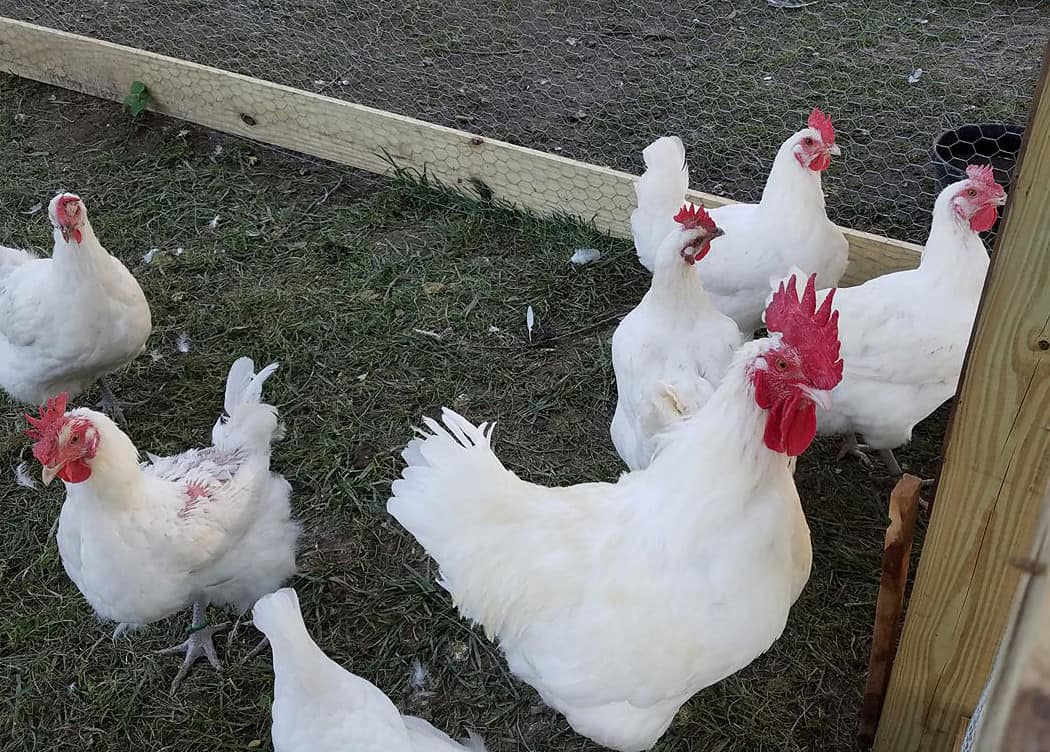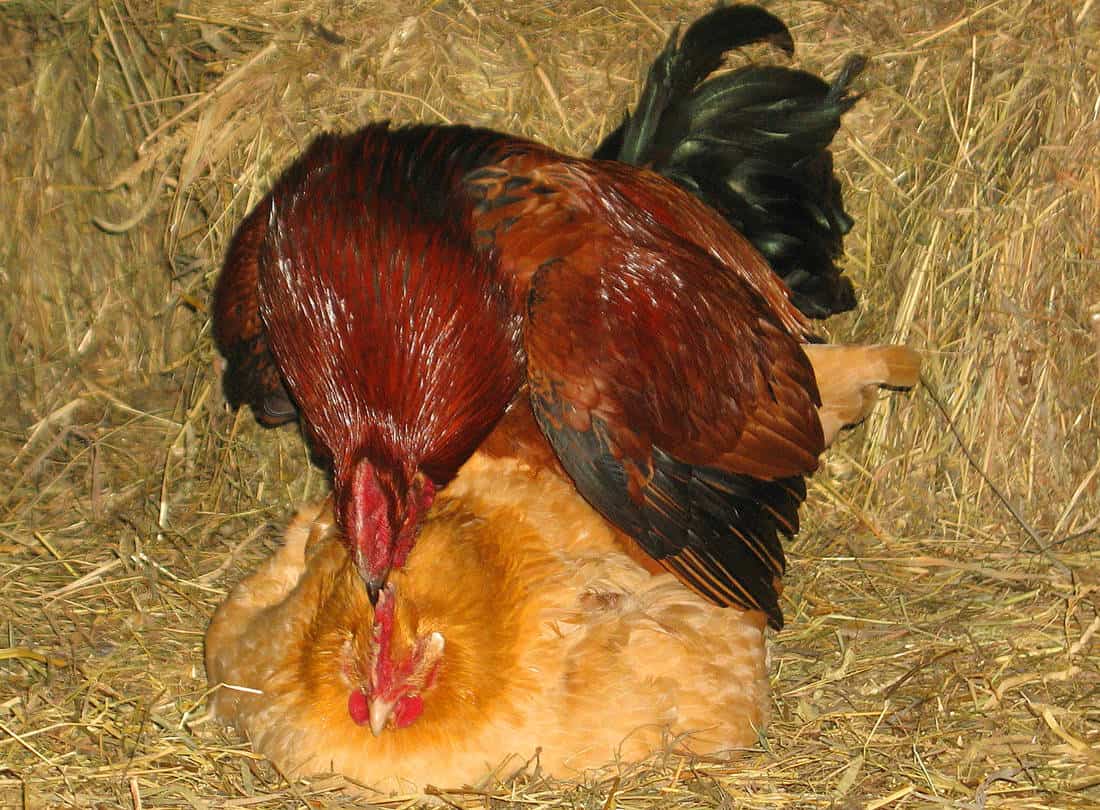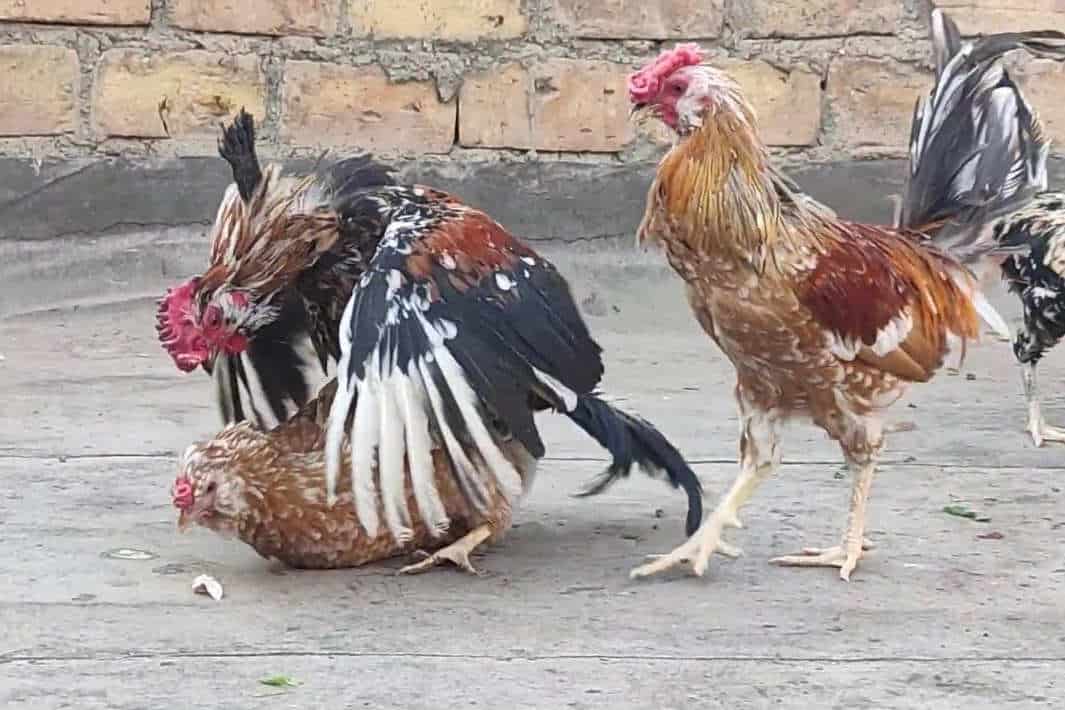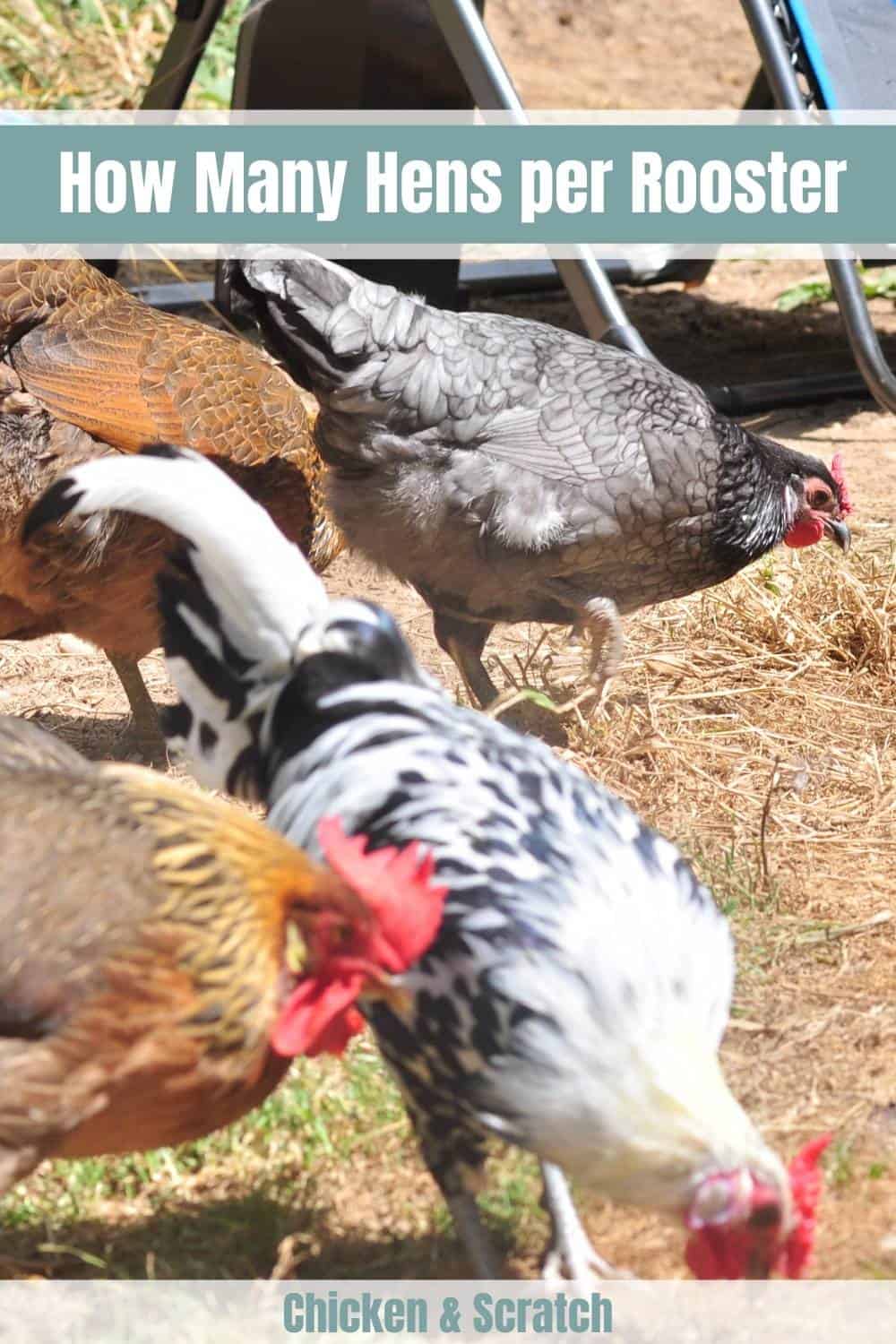Many chicken producers, primarily newbies, usually ask how many hens per rooster they need to have a productive flock. Are you one of them too? End your curiosity; after following this article, you can quickly grasp the optimal hen-to-rooster ratio. Knowing the optimal ratio is crucial for the balance of your flock and improved egg and chicken production.
This article will cover
- How Many Hens Are Ideal for Each Rooster
- How Do they Mate and How Often
- Advantages of Having a Rooster in Your Flock
- Keep your Rooster from Over-mating and your Hen Healthy
How Many Hens Are Ideal for Each Rooster

The answer to the question of how many hens per rooster generally falls between 4 to 10 hens for every rooster, as suggested by experts. But this number may also depend on the chicken breed your flock has. For a big flock, you can see 2, 3, 4, or more roosters often present without causing any issues. Yet this is too risky for smaller flocks.
Most producers, on the other hand, maintain considerably more roosters with their hens. It is not advisable for the usual backyard flock scenario since the danger of overbreeding is already a possibility. But, if you wind up with far more roosters than anticipated, the best part is that your roosters can still coexist happily, particularly if they were reared with each other as chicks.
Rooster Breed | Hens per Rooster |
Bantam breeds (e.g., Silkie, Sebright) | 4-6 hens |
Medium breeds (e.g., Australorp, Sussex) | 6-8 hens |
Large breeds (e.g., Rhode Island Red, Plymouth Rock) | 8-10 hens |
There is always a leading rooster in every flock’s pecking order, and if there are several roosters in a coop, they often establish their own pecking order.
That is to say, one of the several roosters is designated as the top rooster, while the others are defined as the bottom roosters. The roosters sometimes square off with their lifted hackles; however, the bottom rooster seldom attempts to establish authority over the top rooster, and therefore the battle never escalates.
Top rooster retains all breeding rights and lets its hens firstly consume their goodies, followed by him, and finally by the bottom roosters. One reason for fights among the roosters is when the bottom rooster gets caught attempting to pair with any of his hens in private. The top rooster’s instinct is to drive the bottom rooster away from any of the hens.
Other than that, your hens may get exhausted and retreat to prevent aggressive mating with the roosters. If you see any of these signs or your hens appear to be haggard, you need to act quickly. The best yet easy thing you could do is divide the roosters into different sections in this situation.
Additionally, you can confine your roosters for some days each week to alleviate the hens of the stress of constant mating. This method effectively benefits most flock owners who don’t have a huge backyard area or a big group of chickens in one location.
How Do they Mate and How Often

As the rooster faces its romantic but wild fascination, it does seem as if the rooster sheds all concepts of morality. Climbing the hen’s back, the rooster holds the hen’s shoulders and wings with their foot. He will use his beak to grab the hen’s head or neck, frequently yanking the hen’s neck plumage completely out.
It submissively leads the hen to a bending position, which allows the rooster to deposit their sperm effectively. Although roosters don’t possess a penis, they release and inject their sperm in the same method by rubbing the cloaca. The entire mating process only lasts a few seconds. After the hen is released, it’ll just dust off its plumage and carry on as if nothing happened.
The rooster, wanting to demonstrate his superiority to other chickens watching, would just about instantly start searching for his next target.
When you see how many hens per rooster can mate and how roosters do their mating with their hens, you would assume that roosters are savage creatures. Roosters may behave savagely in many aspects, but despite their amour incapacity, your rooster is just concerned with the welfare of his hens.
A rooster could mate between 10 to 30 times or even more times a day with multiple hens, relying on his mood and the accessibility and availability of hens. And, of course, with the competition and rivalry on the flock with other roosters around. Nevertheless, the quantity of sperm a rooster can shoot is rarely fewer than a hundred million, which is needed to sustain excellent viability.
Whenever normal mating happens right after the eggs are produced by a hen, increased fecundity occurs. But, if hens are mating often or every day, there is rare to have a detectable change in fertility irrespective of the timing of matings. A rooster will persuade his hens to mate with him in a natural and healthy environment.
Usually, the rooster will do a ritual-like dance to woo his target hen before doing the mating process. You may observe the rooster dropping one wing and performing in a circling manner around the hen. When the hen is willing, it will bend and let the rooster be on top.
Adjusting the Mating Ratio

Introducing or Removing Roosters
If you need to adjust the mating ratio in your flock, one approach is to add or reduce roosters as needed. This can ensure a healthy level of hens per rooster and keep things happy between the flockmates.
When adding a new rooster, it’s important to introduce him gently. Too fast could lead to fighting and arguments with existing males. Similarly, if tensions are high due to an imbalance of males or if a specific fella has been causing trouble, reducing their numbers may help bring peace back into the coop.
Balancing the Ratio Based on Flock Behavior
Keep an eye on your chickens’ behavior and how they interact to make sure the mating ratio is balanced. If you spot a hen who looks worn out from too much mating, consider bringing down the number of roosters or upping the number of hens for them to have a break.
Try Alternatives
Considering alternative management strategies to get a balanced mating ratio? Don’t worry, you’ve got options. You could try separating feeding groups so everyone gets their fair share of mates.
Or maybe give artificial insemination a go if precision is key. If none of these seems to work, a nice and even rotation of roosters can also help keep the balance in the flock.
Keep an eye out for the mating ratio of your flock and stay on top of how they’re behaving, how fertile they are, and the overall vibe within your chickens. Doing this will ensure that you’ve got a healthy and productive home for them!
Advantages of Having a Rooster in Your Flock

Roosters may provide various benefits to your flock. Although some consider it a terrible choice, there are numerous significant advantages to including them in your flock. Implantation, flock protection, and attractiveness are only a few of these advantages. Generally, roosters are a straightforward and economical method to expand the number of your flock.
Some flock owners have a few hens and seek to expand their flock or increase the demand for eggs. One of the most effective methods to increase the number of the population of your chickens is to add a rooster. But be sure to have a piece of knowledge about the idea of how many hens per rooster you should have to avoid some flock issues.
Great for Mating
A rooster can mate with the majority of the flock’s hens. When fertilized eggs are obtained, all that is required is a secure nesting area for the laying hens. An additional advantage is that fertilized eggs can be consumed in the same sense as unfertilized ones.
It implies that you can keep many birds without sacrificing the advantages of getting fresh eggs. Another advantage of adding a rooster is they act as a guardian or leader of the flock.
The rooster notifies the hens when he discovers food, regulates the pecking order, directs the hens’ movement, and maintains their security. The existence of a rooster in a flock guides and manages the flock as a whole.
Excellent Security
One of the most notable advantages of adding a rooster to your flock is the security it offers from dangers, including predators. One of the primary functions of a rooster is protection from any threat by constantly looking over the entire flock. While they may sometimes seem hostile, they are frequently on the watch for predators on the ground and even in the sky.
Physically Appealing
Lastly, roosters enhance the attractiveness and vibrancy of your flock. A rooster’s colorful plumage makes them the lovely chicken in the flock. The vibrant hues of their plumage aid in the hen’s productivity and serve as a deterrent to potential predators.
Chickens are among the most cost-effective agricultural animals. They represent an excellent investment. Adding a rooster to your flock could make the returns larger than before.
Keep your Rooster from Over-mating and your Hen Healthy

Once you’ve been around sexually mature roosters, you’ve probably observed that certain roosters aren’t very delicate towards the hens and could think about how many hens per rooster you should have. You can occasionally have the calmest and lovely roosters in your flock. However, you could also encounter a few obnoxious and violent roosters.
Sometimes, you may be dealing with a teenager transitioning to manhood who has not yet adjusted to his rooster responsibilities. In other instances, costly producing roosters are hard to replace. In such instances, you may need to consider different strategies for coping with this kind of overaggressive rooster.
Having a flock with a quality top rooster, hens are typically alright with the top rooster’s regular mating. But, when several roosters fight for supremacy or if one rooster is obsessive, it may harm the flock’s hens. During mating, the rooster would use his beak to grasp the head of the hen or her comb and stomp her back.
If this is frequently and forcefully done, hens lose plumage and may even develop back and head sores. As a result, it is crucial to ensure that your chickens are appropriately attended, to avoid injury or over-mating.
Managing a flock with the presence of roosters involves experience and experimentation. Whether you have one, two, or more roosters, you can be confident that your flock will not grow bored.
Roosters have the instinct to establish superiority over their fellow roosters in their flock. If more roosters are vying for dominance, taking away one or even more of them can soothe the flock. Additionally, by including distractions in the flock, you can divert a few of the flock’s attention and give them a pause.
When an overenthusiastic rooster is too intimate with his hens and tends to over-mate, the rooster’s spurs can harm the hen’s back or neck from too much stomping. Even when you remove the spur, it does not entirely resolve the problem of an overaggressive rooster, but it can alleviate some of the hens’ distress.
As a final resort, you may have to consider your overaggressive rooster being removed from the flock. There are far too many excellent roosters to choose from than to gamble your hen’s health on a habitual offender.
Summary
A rooster has been recognized to service up to ten hens single-handedly. However, this varies according to breed and circumstances. Now that you know the ideal ratio of roosters to hens, you can better meet the requirements of your backyard flock. They are beneficial, and their manly crow is a sense of confidence in your flock.


Joseph Hudson has been raising chickens for over 15 years. In 2018, he completed the Agriculture & Natural Resources program at Mt. San Antonio College. He currently raises over 1400 chickens on his 7.5-hectare farm. He keeps sharing his experience on raising healthy and happy chickens on Chicken Scratch The Foundry.








Thanks, i learned a lot from this info. Godbless.
How long can a Rooster fertilize chickens? hens only lay well for about 2 years. Do Roosters start shooting blanks after 2 years as well? Or do they go on and on?
2-5 years, through the rooster’s entire adult life=, the fertility and reproductive performance of a rooster can decline as they age, so their ability to fertilize hens may decrease over time.